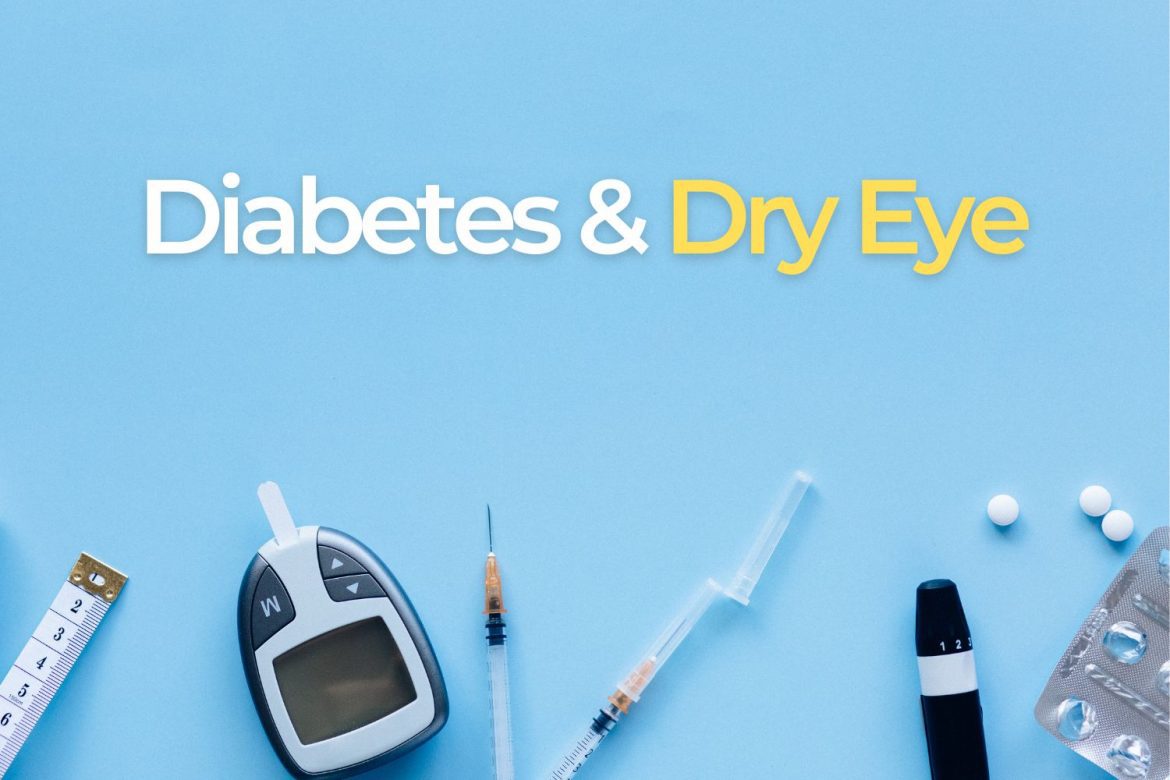
Diabetes is one of the most serious contributors to vision issues. In fact, medical experts believe nearly everyone with diabetes will experience some form of diabetes-related vision issue.
While diabetic retinopathy is the most common diabetic-related eye-health condition, an increasing number of people with diabetes are experiencing serious vision issues as a result of a condition known as dry eye syndrome.
Although dry eye syndrome is not considered a significant health issue, when left untreated in people with diabetes, it has been shown to contribute to permanent vision damage and even blindness.
Understanding diabetes
Diabetes is a chronic health condition that affects your body’s ability to turn food into glucose (sugar) that is used for energy. As your body releases glucose into your bloodstream, your blood sugar level increases. When your blood sugar level increases, your pancreas releases insulin. Insulin is what lets blood sugar into your cells so it can be used for energy.
As diabetes progresses, it interferes with your body’s ability to produce and/or use insulin. When this happens, too much sugar stays in your blood and your cells do not get the energy they need. Over time, chronically increased blood sugar levels can lead to serious health issues, including heart and kidney disease, circulatory issues, and vision loss.
Currently, it’s estimated that over 35 million people in the United States are diagnosed with diabetes. Roughly 95% of people with diabetes have type 2 diabetes. Type 2 diabetes tends to develop over several years and can often be prevented or delayed with weight loss, eating healthy, and regular exercise.
CDC estimates nearly 100 million, or one-third of U.S. adults are considered prediabetic. Prediabetes is a condition where blood sugar levels are constantly higher than normal but not high enough to be diagnosed as diabetes.
People with prediabetes are at increased risk of developing the same serious health issues as those diagnosed with diabetes. And, alarmingly, 80% of those considered to be prediabetic are currently unaware they have the condition.
Understanding dry eye syndrome
Your eyes require healthy tear production in order to stay lubricated and function properly. Dry eye syndrome occurs when your eye is unable to produce enough tears or when tears evaporate too quickly. Common signs and symptoms associated with dry eye syndrome include:
- Stinging or burning
- Blurred vision
- Gritty sensation
- Redness
- Increased sensitivity to the sun, wind, or other environmental stimuli
While most cases of dry eye are temporary and go away on their own, chronic dry eye caused by diabetes can be a serious health condition that requires medical attention.
The American Diabetes Association estimates 5 to 15% of adults experience symptoms of dry eye on a regular basis. However, nearly 55% of people with diabetes will experience serious symptoms associated with chronic dry eye syndrome.
The connection between dry eye syndrome and diabetes
Dry eye syndrome can result from a number of factors, including environmental factors, pollution, allergies, age, or by taking certain medications. However, research has consistently shown that people with diabetes are at an increased risk of developing dry eye syndrome.
Diabetes-induced dry eye syndrome is most commonly a result of damage to the nerves that support normal, healthy function of the eyes and eyelids. Specifically, nerve damage caused by chronically high blood sugar can affect the glands that are responsible for producing tears. Damage to the lacrimal and meibomian glands reduces the production of tears and interferes with the eye’s ability to lubricate itself properly.
Over time, and if left untreated, dry eyes resulting from diabetes can cause chronic eye pain, scarring of the cornea, and even permanent vision loss.
How to treat dry eye syndrome when you have diabetes
Considering 80% of people who are prediabetic are unaware they even have the condition, it’s important to see an eye doctor whenever symptoms associated with dry eyes do not improve after a few days or if the condition reoccurs frequently.
Dry eye treatment will often depend on the severity of the condition and what treatments are already included in your diabetes management plan. For dry eyes caused by diabetes, the most important step is to reduce blood sugar levels to a manageable range.
In most cases, people with diabetes notice their dry eyes improve once their blood sugar is lowered to a stable and consistent level.
Most eye health professionals will recommend treatment of this condition with artificial tears as a way to supplement your natural tear production. Your medical provider might also recommend antibiotic or steroid eye drops to reduce inflammation in and around the eyelids, medicated drops or gels to induce tears, therapeutic contact lenses, in-office light therapy treatment, or moisturizing ointments designed to increase lubrication while you sleep.
In addition, your doctor may recommend a number of at-home strategies designed to reduce symptoms associated with dry-eye syndrome, including:
- Staying hydrated
- Using a humidifier to increase moisture levels in the air
- Taking frequent breaks from phones, computers, and other digital devices
- Wearing sunglasses or protective eyewear when out in the sun, wind, or other elements
- Avoid common eye irritants such as smoke.
Diabetes contributes to a number of significant health problems. Dry eye syndrome is not only the result of damage caused by high blood sugar and diabetes, but can also be a warning sign for those unaware they might have either condition.
In addition to preventing serious and permanent damage to your vision, early identification and treatment of diabetes-related dry eye syndrome can also help your doctor identify other serious diabetes-related vision disorders, including diabetic rhinopathy, diabetic muscular edema, cataracts, and even glaucoma.

